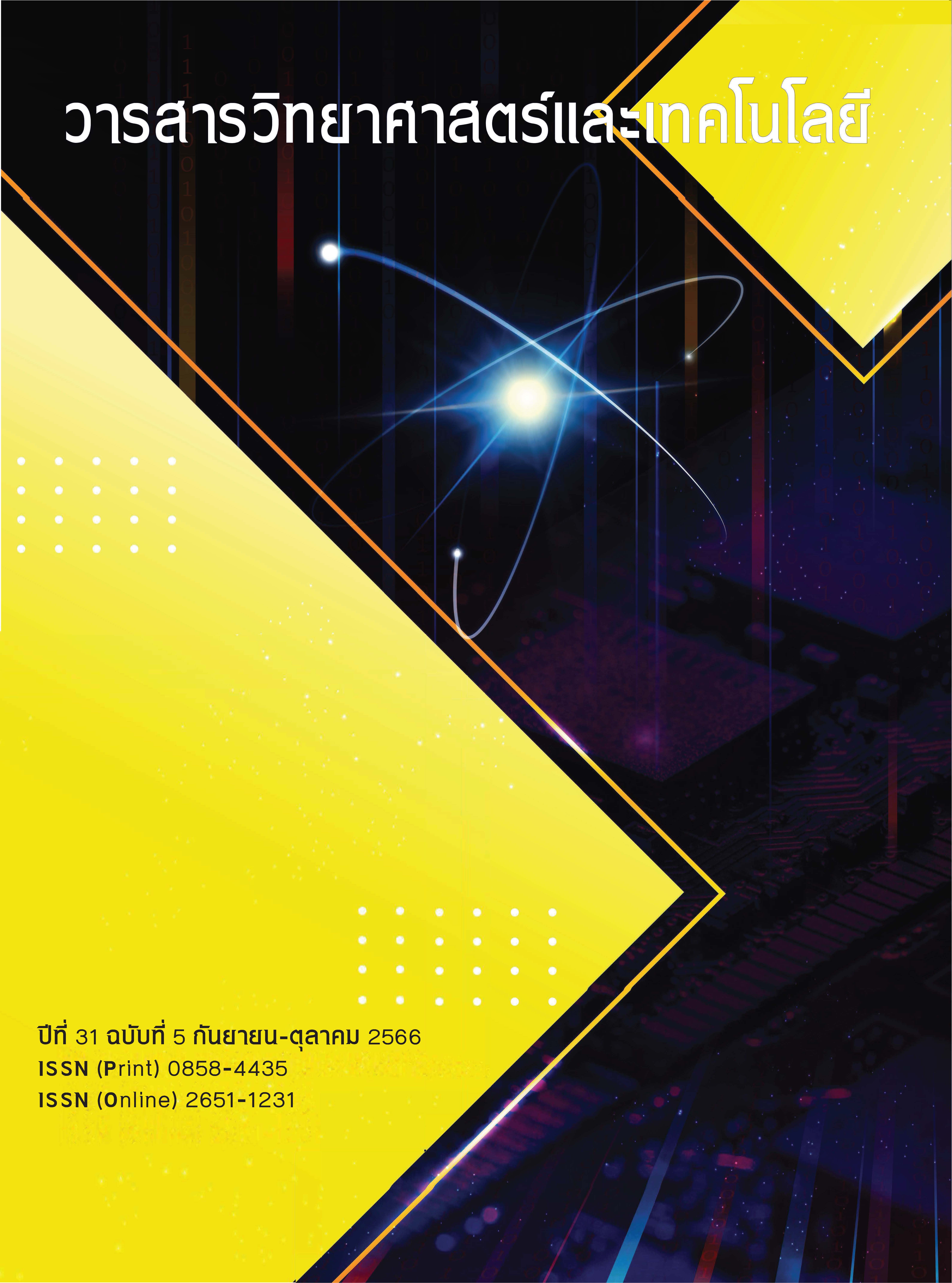Simulation Study of Integrated Gasification Combined Cycle System: Case Study of Rubber Wood Sawdust and Municipal Solid Waste Pellets
Main Article Content
Abstract
This research investigates an integrated gasification combined cycle (IGCC) system utilizing rubber wood sawdust and municipal solid waste pellets as feedstock in a downdraft gasifier. The study aims to evaluate optimal operating conditions that maximize total power and power efficiency. A simulated process was conducted using the ASPEN Plus V.12.1 program to study various operating variables, including gasification temperature (700-1200°C), steam to biomass ratio (S/B) (0-1), and compression ratio (14-22). The results reveal that increasing the gasification temperature resulted in a reduction in the syngas compositions of H2, CO2, and CH4, while CO and steam increased. In addition, increasing the steam to biomass ratio (S/B) resulted in higher H2, CO2, and steam in the syngas, while CO and CH4 decreased. H2 and CO were identified as the primary syngas compositions for power generation. For the generation of high total power, the optimal operating conditions were found to be a gasification temperature of 1200°C, an S/B ratio of 1, and a compression ratio of 14. Under these conditions, the total power output from rubber wood sawdust and municipal solid waste pellets was 5.55 MW and 5.30 MW, respectively. Moreover, for achieving high power efficiency, the optimal operating conditions were determined as a gasification temperature of 1200°C, S/B ratio of 0.2, and a compression ratio of 14. The power efficiency for rubber wood sawdust and municipal solid waste pellets was 31.85% and 38.49%, respectively.
Article Details
References
Energy Policy and Planning Office., Trend of energy consumption in 2023, Available Source: https://www.eppo.go.th/index.php/th/component/k2/item/18695-news-090165-01, June 16, 2023. (in thai)
Ministry of Energy., Strategic environmental assessment project for the construction of a coal power plant in the Southern part, Available Source: https://www.egat.co.th/home/wp-content/uploads/2022/05/รายงานฉบับสมบูรณ์.pdf, May 31, 2023. (in thai)
Ali, A.M., Shahbaz, M., Shahzad, K., Inayat, M., Naqvi, S., Al-Zahrani, A.A., Rashid, M.I., Rehan, M. and Mahpudz, A.B., 2022, Polygeneration syngas and power from date palm waste steam gasification through an Aspen Plus process modeling, Fuel. 332: 126120.
Niu, M., Xie, J., Liang, S., Liu, L., Wang, L. and Peng, Y., 2021, Simulation of a new biomass integrated gasification combined cycle (BIGCC) power generation system using Aspen Plus: Performance analysis and energetic assessment, International journal of hydrogen energy, 46: 22356-2236.
Song, H., Yang, G., Xue, P., Li, Y., Zou, J., Wang, S., Yang, H. and Chen, H., 2022, Recent development of biomass gasification for H2 rich gas production, Applications in Energy and Combustion Science. 10: 100059.
Mishra, S. and Upadhyay, R.K., 2021, Review on Biomass Gasification: Gasifiers, Gasifying mediums, and Operational parameters, Materials Science for Energy Technologies. 4: 329-340.
Duan, W., Yu, O., Wang, K., Qin, Q., Hou, L., Yao, X. and Wu, T., 2015, ASPEN Plus simulation of coal integrated gasification combined blast furnace slag waste heat recovery system, Energy Conversion and Management. 100: 30-36.
Wang, T., 2017, The gas and steam turbines and combined cycle in IGCC systems, Integrated Gasification Combined Cycle (IGCC) Technologies. 490-640.
Supawimon, P., 2013, Simulation and analysis of combined cycle power plant from synthesis gas by biomass gasification, Master thesis, Chulalongkorn University, Bangkok, 39 p. (in Thai)
Ge, H., Zhang, H., Guo, W., Song, T. and Shen, L., 2018, System simulation and experimental verification: Biomass-based integrated gasification combined cycle (BIGCC) coupling with chemical looping gasification (CLG) for power generation, Fuel. 241: 118-128.
Izzatie, N.I., Basha, M.H., Uemura, Y., Hashim, M.S.M., Afendi, M. and Mazlan, M.A.F., 2019, Co-pyrolysis of rubberwood sawdust (RWS) and polypropylene (PP) in a fixed bed pyrolyzer, Journal of Mechanical Engineering and Sciences. 13: 4636-4647.
Waiyanate, P., 2016, The effects of microwave absorbers on the torrefaction of highly-moist municipal solid waste (MSW) pellets, pp. 36, In Prapasin, P., and Pattanavibul, A., Comparison study of hydrogen production processes by simulation using ASPEN Plus Program, Department of chemical engineering faculty of engineering, Thammasat University, Pathumthani. (in Thai)
Deng, N., Zhang, A., Zhang, Q., He, G., Cui, W., Chen G. and Song, C., 2017, Simulation analysis and ternary diagram of municipal solid waste pyrolysis and gasification based on the equilibrium model, Bioresource Technology. 235: 371-379.
Marcantonio, V., Falco, M.D., Capocelli, M., Bocci, E., Colantoni, A. and Villarini, M., 2019, Process analysis of hydrogen production from biomass gasification in fluidized bed reactor with different separation systems, International Journal of Hydrogen Energy. 44: 10350-10360.
Antonopoulos, I.S., Karagiannidis, A., Gkouletsos, A. and Perkoulidis, G., 2011, Modelling of a downdraft gasifier fed by agricultural residues, Waste Management. 32: 710-718.
Puig-Gamero, M., Argudo-Santamaria, J., Valverde, J.L., Sánchez, P. and Sanchez-Silva, L., 2018, Three integrated process simulation using, Energy Conversion and Management. 177: 416-427.
Yin, F., Shah, K., Zhou, C., Tremain, P., Yu, J., Doroodchi, E. and Moghtaderi, B.,2015, Novel calcium-looping-based biomass-integrated gasification combined cycle: Thermodynamic modeling and experimental study, Energy and fuels. 30(3): 1730-1740.


